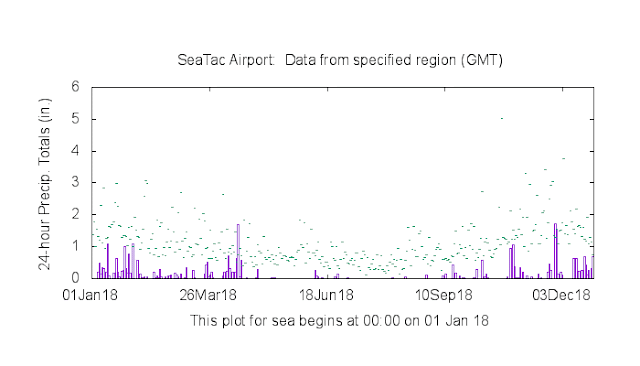2019 was generally a drier than normal year. But there were few fires during the summer and little smoke in western Washington and Oregon. How can that be? And agriculture was generally fine.
So let's talk about this year's precipitation, which we can do since there is only a few days left of the year.
There
will be some rain the next few days, but nothing serious over Washington (see the prediction for accumulated precipitation for the rest of the month). Around a half-inch over the lowlands, a few inches in the mountains. In fact, with general westerly flow, Puget Sound will be substantially rainshadowed by the Olympics. Much more over coastal British Columbia.
But let's look backwards to the beginning of the year. As shown by the map below, California, Nevada, and southeast Oregon have been very wet, but western WA has been quite dry, much of it with 70-90% of normal. Not the end of the world, but less than normal. The moisture over California played a big role in keeping the fires down and ensuring plenty of water there.
However, the annual precipitation total does not tell the whole story. Below is a plot of the accumulated observed (purple) and normal (cyan) precipitation for this year at SeaTac.
The year started near normal, but we fell behind in spring, but slowly caught up during summer...that will be important. A wet September almost brought SeaTac to normal. Then we had a very dry October/November and Seattle fell to 10-12 inches behind. But fortunately, the big rain of last week got us to a few inches below normal. An meteorological roller coaster ride!
In contrast, Quillayute, on the WA coast, was not only drier than normal, but did not get the big atmospheric river rain experienced by Puget Sound and SW Washington. Shows how narrow the atmospheric river was. They are a good ten inches below normal right now. But really no serious implications of this....they still received 70 plus inches.

Yakima, on the eastern side of the Cascades, ended up
wetter than normal, thanks to a very, very wet February/March
So why few fires this summer, while 2018 had things ablaze. Particularly since the overall rainfall here in Puget Sound was nearly the same during both years. One explanation: precipitation were very different during the summer between the two years. To show this, here are plots of the daily precipitation for 2019 and 2018. For 2019, we had frequent light amounts throughout the summer. Keep things cool and relatively moist.
In contrast, 2018 had long summer period without rain. THAT made a huge difference. The smoky year or 2017? A year that had much more precipitation. 2017 had a very extended dry period during the summer (see below)
So the natural question you might ask, are our summers getting drier or were the last few years just random excursions? Below is a plot of July/August rainfall totals over Puget Sound for 1900-2019--a good measure of what is coming into the region (this is the NOAA climate division precipitation for WA Division 3).
2017 and 2018 had very low summer totals, and you can see the rebound in 2019. In fact, 2017 was the lowest since 1930! Is there a long-term trend. Really hard to say. Not much over the entire period, but a drying trend over the past 40 years.
What would we expect under global warming?
Well, I am in a position to give you some new information on this. We have run high-resolution regional climate models for 130 years (1970 to 2100. And we did this for an ensemble of many (12) global climate models. The results, shown below for Seattle for a VERY aggressive increase in CO2 (we go crazy with coal!), indicates a very, very slow downward trend of summer precipitation.
My conclusion: low precipitation for 2017/2018 was probably just random chance--good news for our future summers the next few decades.

















 Yakima, on the eastern side of the Cascades, ended up wetter than normal, thanks to a very, very wet February/March
Yakima, on the eastern side of the Cascades, ended up wetter than normal, thanks to a very, very wet February/March




































